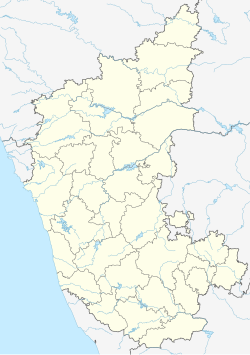Banavasi: Difference between revisions
Upendrapai (talk | contribs) Tags: Mobile edit Mobile app edit Android app edit |
No edit summary Tags: Mobile edit Mobile app edit Android app edit |
||
| Line 1: | Line 1: | ||
{{Short description|Tourist destination near Sirsi, Karnataka}} |
|||
{{Use dmy dates|date=May 2018}} |
{{Use dmy dates|date=May 2018}} |
||
{{Use Indian English|date=May 2018}} |
{{Use Indian English|date=May 2018}} |
||
Revision as of 17:29, 16 November 2022
Banavasi | |
|---|---|
Village | |
 Madhukeshwara Temple at Banavasi | |
| Nickname: Pampana Banavasi / ಪಂಪನ ಬನವಾಸಿ | |
| Coordinates: 14°32′03″N 75°01′04″E / 14.5341°N 75.0177°E | |
| Country | |
| State | Karnataka |
| District | Uttara Kannada |
| Taluq | Sirsi |
| Nearest Large City | Sirsi |
| Population (2005) | |
• Total | 4,267 |
| Languages | |
| • Official | Kannada |
| Time zone | UTC+5:30 (IST) |
| PIN | 581 318 |
| Telephone code | 08384 |
| Vehicle registration | Sirsi KA-31 |
Banavasi is an ancient temple town located near Sirsi in Uttara Kannada in the South Indian state of Karnataka. Banavasi was the ancient capital of the Kannada empire Kadamba that ruled all of modern-day Karnataka state. They were the first native empire to bring Kannada and Karnataka to prominence.
History
Banavasi is the oldest town in the Karnataka state.[1] It has grown up around the Madhukeshwara Temple built in the 5th century and dedicated to Shiva[2] the supreme God in Shaivism, a major branch of Hinduism.


5th-century copper coin was discovered here with an inscription in the Kannada script, one of the oldest such coins ever discovered.[3]
Adikavi Pampa, the first poet of Kannada, wrote his epics in Banavasi.
The town once was the capital of the Kadamba rulers, an ancient royal dynasty of Karnataka.[4] They established themselves there in A.D. 345 and ruled South India for at least two centuries.[5]
Banavasi contains some of the oldest architectural monuments in southern India.
Location
Banavasi lies in Malenadu region and is surrounded by forests and villages, with the Varada river flowing around it on three sides. Sirsi, is the nearest town about 23 km away. It is 400 km from Bengaluru. The nearest railway stations are 70 km away in Haveri and Talaguppa. The district Headquarters is Karwar.
Agriculture
The soil is fertile around Banavasi and paddy, wheat, sugarcane, arecanut, spices and pineapple are grown. Its specially known for pineapples, bananas and ginger. There are many pineapple farms on the edge of the village.
Attractions
The annual December cultural festival, Kadambothsava, is a huge gathering, organised by the state government, and featuring folk dancers, drama troupes, classical musicians, art exhibitions while drawing together performers, artists, and writers from throughout south India.
Banavasi has long been a cultural centre, especially the Yakshagana art form. Today local artisans craft and sell the classical folk art Yakshagana masks here.
Gallery
-
Madhukeshwara Temple at Banavasi
-
Nandi (bull) in Mahamantapa (hall)
-
Throne carved of Stone at Madhukeshwara temple
-
Elephant at the entrance
-
Madhukeshwara Temple
-
Sunset at Madhukeshwara Temple at Banavasi
See also
References
- ^ Kamat, Jyotsna (6 August 2006). "Ancient City of Banavasi". Archived from the original on 20 August 2006. Retrieved 17 August 2006.
- ^ "Banavasi- 'Kadambothsav'". BangaloreBest.com. Archived from the original on 4 February 2012. Retrieved 17 August 2006.
- ^ "5th century copper coin discovered at Banavasi". Deccan Herald. 5 February 2006. Archived from the original on 14 June 2006. Retrieved 17 August 2006.
- ^ Kamat, Jyotsna (5 August 2006). "Kadambas of Banavasi". Archived from the original on 4 September 2006. Retrieved 17 August 2006.
- ^ "South Indian Coins - The Kadambas of Hangal". Archived from the original on 15 August 2006. Retrieved 17 August 2006.








